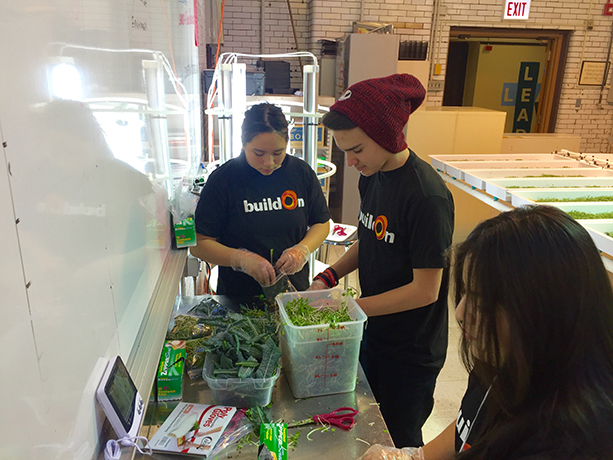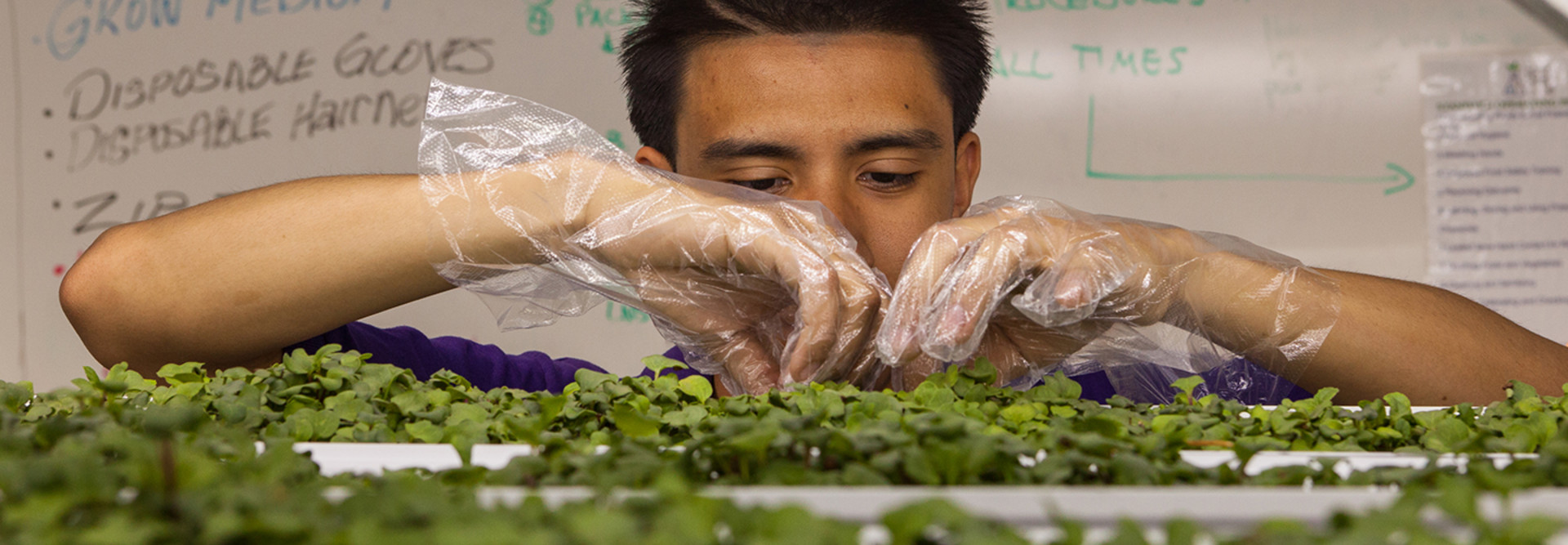Students Find STEM Solution for Food Crisis
Humanity’s future may be taking shape in an overlooked shop space at Carl Schurz High School in Chicago.
At the school is a “food computer,” a proof of concept created by two students, Diego Nava and Diana Guallpa, while participating in a unique program at the school: the Schurz Food Science Lab.
This pilot program, co-founded by Jaime Guerrero, a local marketing executive and urban farming advocate, along with the nonprofit group Arts Alive Chicago, has provided students with a working lab within which they are able research urban farming and nutrition, while also receiving vocational training in 21st century farming techniques.
“I like to say the Food Science Lab covers STEM and goes beyond it, touching on agriculture, the arts,” explains Guerrero. “The science behind it — the technology, engineering, mathematics — those are the core elements. The students are able to use all different parts of their brain there.”
Examining a Growing Worldwide Threat
With climate change and continued population growth affecting every corner of the globe, food security has become a very real concern. The United Nations’ World Food Programme predicts that climate change could increase the risk of starvation and malnutrition by up to 20 percent by 2050.
But food security is also a local issue. Within Chicago itself, food deserts continue to be a problem, despite Mayor Rahm Emmanuel’s efforts to address this issue with a “Produce Bus” that travels through neighborhoods, offering fresh produce to low-income communities.
Students in the Food Science Lab understand on a very real level that food security is an issue that they will have to tackle. “We are the generation that needs to worry about climate change so that future generations have healthy food,” explains Guallpa.
Creating a Digital Garden
The concept for the food computer grew out of the Open Agriculture Initiative at MIT, a program dedicated to developing open-source hardware and software platforms for sensor-controlled hydroponic and aeroponic agriculture systems. A food computer is basically an insulated box — outfitted with digital sensors that control and monitor climate, energy and plant growth — in which to grow plants and vegetables. The sensors monitor such wide-ranging variables as carbon dioxide levels, air temperature, humidity levels, dissolved oxygen, potential hydrogen, electrical conductivity, and root-zone temperature.
With the ability to monitor and control all of these common agricultural growth variables, the food computer is a system that could be set up anywhere in the world, under most conditions, to grow healthy produce. It offers a solution to one of the great unknowns that confront humanity as it faces the changes wrought by climate change.

Students at Schurz High School in Chicago work in the Food Science Lab. Photo courtesy of Schurz Food Science Lab.
The Tech on the Inside of the Food Computer
Guallpa and Nava developed their proof-of-concept food computer in the Food Science Lab. The technology that goes into it is fairly simple, Guerrero explains.
“There’s an Arduino Uno platform, where the sensors will connect. The Arduino is connected to the Raspberry Pi 2 B, the brains of the food computer; and that connects directly to the internet. Once we’ve got sensors connected to the Arduino, we’ll be sharing and displaying data on the internet, and we’ll control everything through a dashboard set up on the laptop,” says Guerrero.
The rest of the food computer’s setup includes a Dell display, where the dashboard will appear; a Dell notebook to input commands to the dashboard; and a D-Link camera to stream video from inside the food computer.
Internet connectivity, which allows sensor data to be stored and shared, is key to the food computer concept. There’s the potential for multiple data inputs to be collected worldwide over time. All of that data could then be analyzed to determine the ideal growing conditions for a given fruit or vegetable. That could could make the ideal “recipe” for growing spinach, for example, available to anyone, whether they live in the Central Valley of California, a drought-plagued area of Haiti, or a war-torn village in Syria.
In other words: Access to an internet connection and the basic hardware and software of the food computer could allow everyone to grow the same food, everywhere.
Teaching Students New STEM Skills
“This has been a very student-driven initiative,” explains Mitch Arsenie, an AP Environmental Science teacher at Schurz and advocate for the Food Science Lab. Nava and Guallpa researched sensors and looked up prices for the hardware. Then they pieced together the hardware and programmed the operating system — a skill set that neither had prior to this project.
“I learned a lot about programming while working on the food computer,” explains Nava. “Being able to work on a prototype like that was really rad. And beyond that, I learned so much about agricultural systems.”
On the surface, the food computer is teaching kids about indoor gardening and the vocation of farming. But the takeaway for Nava and Guallpa has clearly been so much more.
“At Schurz, both of these kids picked up great analytical and problem solving skills from the AP environmental and engineering programs they’re both a part of. It was so cool to see those skills applied to this new technology, the food computer. This idea is straight from MIT — no high schoolers in Chicago had done anything with it before. No one could have done it alone; it took them working as a team,” says Arsenie.
Even students at Schurz not directly involved are reaping the benefits of the work done in the Food Science Lab.
“We get to share what we grow with the cafeteria, so students here at Schurz can eat fresh greens,” says Guallpa. “We’ve put a sign up explaining how we’re growing it, and the other students love it, love being able to have fresh salad at lunch.”
Today, Schurz is one of few schools in the Chicago Public School district that’s growing food hydroponically and serving it in the school cafeteria, thus providing food for kids who normally wouldn’t have the option to eat “fresh and local.”
Blazing Trails for Future Students
Nava and Guallpa, who didn’t complete their food computer before they graduated, have started a project that will carry on after them. Guerrero hopes to have students finish connecting the sensors and start gathering data from the computer in the fall.
“Our next step is going to be having the students build a different growing box that’s much closer to the MIT project’s dimensions,” says Guerrero.
Arsenie sees increasing relevance to the kind of work that Guallpa and Nava accomplished.
“This generation of students doesn’t know where their food comes from – it’s as much a social and environmental issue as an educational one,” he says. “We are missing something that would close that loop and truly connect the theoretical and practical applications of science.”









